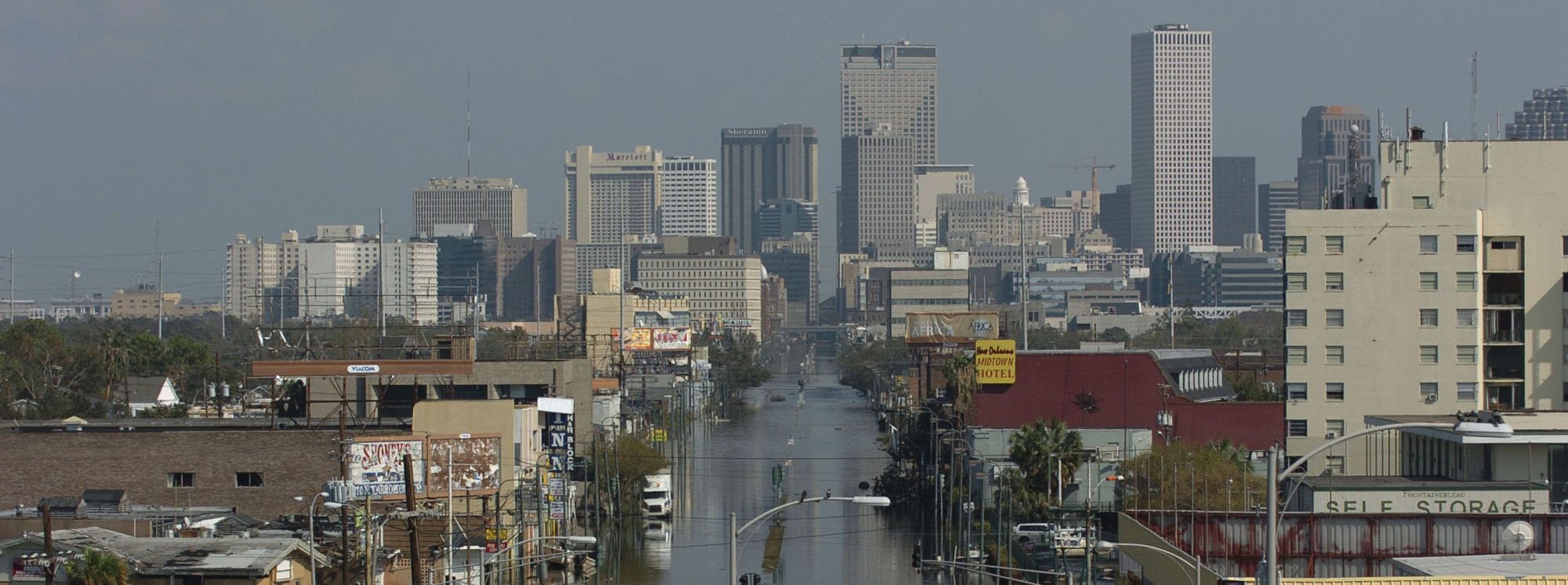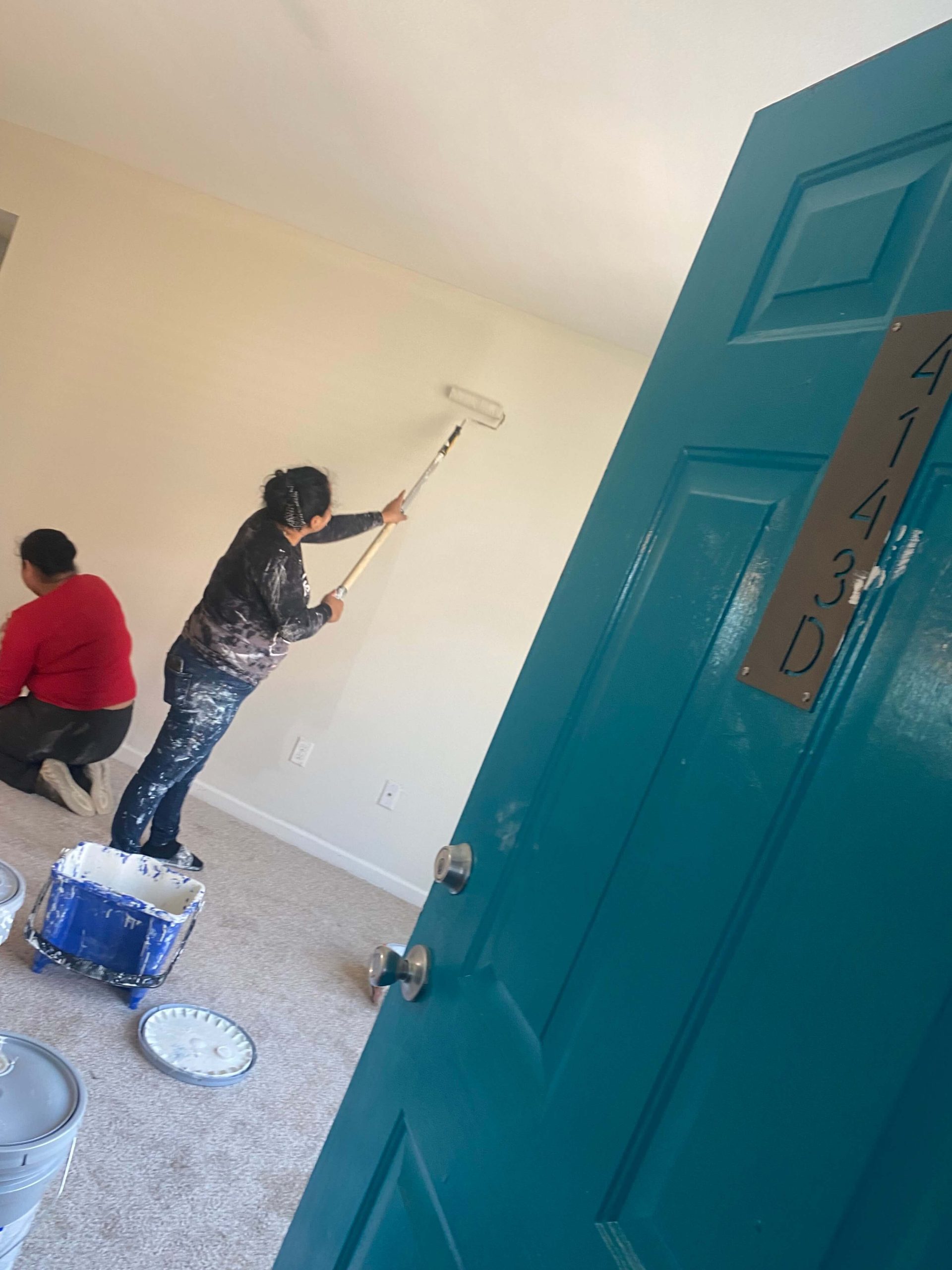
Climate, Government, Immigration
Inside an industry fueled by climate change
Table of contents
Who’s responsible for the safety of workers who rebuild American cities after natural disasters? It’s a complicated answer.
This article was produced in partnership with Columbia Journalism Investigations and the Center for Public Integrity. It was co-published by Futuro Investigates, a division of Futuro Media.
The headaches started within two weeks of their demolition and painting of dozens of mold-infested apartments. Then came the nosebleeds. Jenny and her 11 family members pooled their money to buy $30 protective masks and bottles of Advil and other over-the-counter medication to soothe the discomfort just enough to keep working.
The men tore out the moldy walls left behind by flooding, installing new sheetrock, cabinets and bathroom tubs, before the women painted dozens of luxury apartments at the Mayfair Apartment Homes in New Orleans’ Aurora Gardens neighborhood, almost a year after Hurricane Ida. As they showed up for work every morning, they ignored their aching bodies because the family needed the money. Their symptoms lingered until they stopped working in November 2022, when they say the unlicensed contractor that hired them stopped communicating with them despite owing them $53,000 in back wages.
“He left us without a penny,” Jenny said of her first season as a disaster-restoration worker. She and her family were recruited to the industry via text, and later found this job after Jenny had noticed the Mayfair Homes’ ongoing construction and approached the property’s leasing office. She said she was instructed to call the contractor.

Jenny, in black, and sister, Abigail, in orange, paint an apartment after her family members tore out moldy walls. Jenny and 11 of her family members worked for four months at the Mayfair Apartment Homes in New Orleans. (Photo courtesy of Jenny)
Columbia Journalism Investigations and The Center for Public Integrity are not publishing the full names of Jenny and other workers to protect them from potential retaliation.
Fueled by climate change, the disaster-restoration industry has ballooned into a loosely regulated, billion-dollar business described as “the wild west.” As a result, workers like Jenny and her family, hired to rebuild American cities after climate catastrophes, often don’t receive protective gear or the training needed to minimize exposure to toxic substances like mold, asbestos and lead.
An investigation by CJI and Public Integrity found that many disaster-restoration workers are exposed to known carcinogens and toxic substances, often unwittingly and without protections, which can make them sick. Some suffer debilitating health issues long after they’ve left cleanup jobs.
The industry’s structure enables companies to go unchecked by local, state or federal officials: larger companies pull in a vast web of contractors and subcontractors to find workers. They often label their workers independent contractors, making them responsible for their own safety training and equipment and allowing the larger companies to skirt responsibility. Workers, and especially immigrants, also become vulnerable to labor abuses, including wage theft.
Mario Mendoza, a disaster relief worker since Hurricane Katrina and founder of the New Orleans-based organization Familias Unidas En Acción, said many workers are hired by what he described in Spanish as a “casi patrón,” or a labor broker. Others are recruited via WhatsApp groups, family and friends, at parking lots of home improvement stores or other high-traffic areas that become informal labor corners, where workers congregate to be hired for a day’s work.
CJI and Public Integrity asked 100 restoration workers primarily based in Florida and Louisiana to share their employment experiences. The majority – 77% – reported working mostly as day laborers, employed by a variety of smaller contractors after being picked up at labor corners. At least eight workers reported working longer contracts for billion-dollar companies like Servpro, hired through their subcontractors.
Both routes carry risks. Often workers arrive at job sites without training or unable to identify the official supervisor. As a result, workers injured on the job can’t report the injury and when they end up in the emergency room, workers often must pay for their own medical care, Mendoza said.
Any construction contractor can turn to this booming industry, because there aren’t any educational requirements to go into disaster restoration, said Robbie Bradshaw, director of government relations for the Institute of Inspection Cleaning and Restoration Certification. “Right now the industry has kind of taken that on themselves.”
Norris Gearhart, who runs a Texas-based restoration company and designs environmental hazard training, said that some companies are unaware or unwilling to pursue even basic education on how to do disaster restoration work properly, let alone the more intense training it would take to mitigate the complex environmental hazards often found onsite.
“Unless the large-scale companies institute and mandate standards, there’s abuse all the way down the subcontracting chain,” said Saket Soni, executive director of Resilience Force, a New Orleans-based advocacy group. “It’s very difficult for high-road actors to survive and succeed because there are so many low-road actors in the subcontracting chain that get ahead by cost-cutting.”
Workers must buy their own protective gear or go without until they can afford it. Nearly three-quarters of the workers who answered the CJI and Public Integrity questionnaire said employers failed to provide any protective equipment.
With few options, workers turn to courts
There are few options to hold companies accountable. After Hurricane Katrina, workers successfully turned to the courts to demand unpaid wages. Fourteen years later, the COVID-19 pandemic created a unique opportunity to demand protective equipment and better conditions, said John Philo, a lawyer who now represents many disaster-restoration workers in another labor-related lawsuit.
In 2020, Resilience Force and the Sugar Law Center for Economic and Social Justice sued a Servpro franchise in Michigan and three subcontractors for allegedly mistreating workers who cleaned up after major flooding driven by unseasonably heavy rains in Midland, Michigan. The workers allege that in the midst of the pandemic, they were denied proper health and safety gear as they tore down water-logged buildings filled with mold.
Servpro is unique: the industry giant lends its name to over 2,000 franchises worldwide. But the plaintiff’s legal strategy included naming Servpro Industries, the national corporation. In response, the billion-dollar company said it had no legal duty to the workers hired by subcontractors, calling them “total strangers.” The judge sided with Servpro, stating that the Michigan court only has jurisdiction over the locally run franchise, not the Tennessee-based company. The franchise — which also goes by RACM — and subcontractors Wallace, Rush, Schmidt and BTN Services denied ‘allegations, court filings show.
The workers attempted to appeal the ruling, to no avail.
Servpro declined to answer specific questions about the lawsuit. “We cannot speak to the specific claims about this work that you are making — since we were not in any way involved,” a spokesperson said in a statement. Servpro added that the health and safety of workers is a critical priority for the company, and that it requires its franchises to adhere to strong health and safety protocols – but declined to outline those protocols.
Philo said the widespread use of subcontractors is intentionally “fracturing any potential for accountability.”
“We haven’t even attempted to develop the mechanisms to both protect the health and safety of the workers.”
Who protects the workers?
Jenny’s family worked for Anatole Christophe, owner of AttaBoi House Painting and Repairs — an unlicensed contractor. Jenny says there was no training or information about the apartment complex where they were working, which was built before the 1980s and likely contains asbestos, according to the U.S. Occupational Safety and Health Administration’s guidance on post-disaster toxic substances. Christophe said that he provided N95 masks and that no one reported health issues to him. Workers deny receiving masks and say there wasn’t an opportunity to report symptoms because AC, as he told the workers to call him, rarely came to the worksite.
Christophe and the site’s property manager, Sheridan LaFrance of O’Brian Realty Group, blame each other for the worker’s unpaid wages. According to LaFrance, the contractor said he would pay the workers what they were owed. But Christophe said he can’t pay the workers until he is paid what he claims to be owed by O’Brian Realty Group.
“It weighs heavy on me that I took my family to work there,” Jenny said in Spanish, holding back tears.
Brad Hassert, compliance director for the Louisiana State Licensing Board for Contractors, said the proliferation of unlicensed contractors after natural disasters is “problematic and a danger to the public.” Hassert said that after Hurricane Ida, the board received 784 complaints from homeowners about contractors.
Workers have no one to turn to for help.
Mendoza advises workers to report safety violations to OSHA. However, the agency suspends standards enforcement after natural disasters, opting for a lenient, ongoing conversation with employers — which relies on companies taking responsibility for safety.
OSHA declined to make Assistant Secretary Douglas Parker available for an interview and instead provided a written statement stressing its commitment to protecting all workers on post-disaster cleanup sites. “We continue to refine emergency preparedness and response work and strategies to better accomplish this mission in response to increasing and more intense climate disasters,” the agency said.
After years of exposure to toxic substances, a generation of workers is sick without a safety net.
In 2019, 76-year-old Eleno returned to El Salvador after toiling on post-disaster worksites for 14 years as an undocumented worker. Eleno worked as a contractor for Modesto Miranda, who owns Crescent City Realty of Louisiana and other LLCs, until he became too blind to work as a roofer. Eleno alleges Miranda still owes him $5,000 in back wages.
Miranda did not respond to multiple calls, texts and registered letters sent by CJI and Public Integrity seeking comment.
Several years after returning to his native country, Eleno laments his lonely fortune, declaring with a nervous chuckle: “I came to my country to die.”


